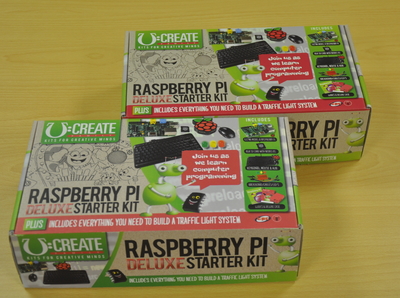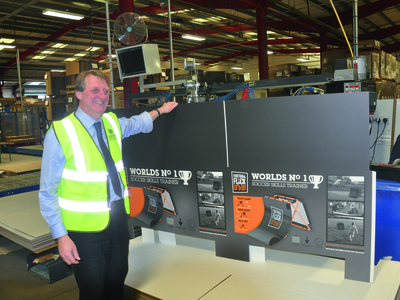Managing director, Ken Shackleton, with an example of the digitally printed displat packaging the company produces
Located near Accrington, in Lancashire, the Cardboard Box Company was founded in 1896 as Chapman’s, and is still in rude health as an independent, looking to the future after investing in a pair of Inca Digital flatbed inkjet presses in 2013. The owner, Peter Street, and managing director, Ken Shackleton, invited Sean Smyth along to see how digital technology is being introduced and to find out how the company is preparing for the next stage in its development.
Despite the name, the Cardboard Box Companyis a BRC and FSC accredited sheetfed corrugated plant, selling primarily to retailers, together with brands and contract packers. The 100,000 square foot factory houses CAD design, graphics, computerised colour matching and ink mixing station, with a board and paper testing laboratory. Turning over some £12 million in 2013, it operates a couple of Martin four colour flexo casemakers joined by a high performance Bobst 618, with gluing and stitching finishers. About 10% of production is litho lamination, with large format sheets bought in for conversion. The plant is extremely clean, with conveyors and auto pallet wrapping, and the company spent £40,000 to paint the floor a clean grey that provides more light while reinforcing the positive working environment.
In the last 18 months, a significant investment programme has been undertaken, with over £2 million spent on additional space to handle expansion, and on the FFG 618 Quatro flexo folder gluer casemaker and two flatbed six colour UV inkjet presses from Inca Digital.
Biding time
The company produces displays, promotional packs, PoS, shelf-ready packs and brown transit boxes. It is looking to provide very high levels of service to retailers and brands, rather than maximising the tonnage converted. It is patenting an innovative display system, mixing flexo and digital to create extremely eye-catching systems that can be used flexibly.
Managing director, Ken Shackleton, has been with the company for 30 years and first looked at digital back in 2000, as a potential alternative to buying in litho sheets for lamination. The quality was not good enough then (not to mention the reliability and productivity). However, he kept an eye on the digital sector and decided that the time to invest was right in 2011, but only to supplement the flexo and bought-in litho, rather than as a replacement. The cost of buying in large format inkjet on paper that was then mounted to produce prototypes and production samples was becoming significant.
In 2012, CBC bought a second-hand Inca Digital Spyder and set up an in-house artwork department, then quickly bought a second new machine. The department handles customer supplied files, setting them up correctly for production ‒ they are pushing the quality of flexo process printing onto corrugated ‒ and offering design services. It has helped the company understand issues facing customers to get good quality flexo and importantly allows CBC to control the artwork.
The Inca Spyders are being used on new jobs with much work to match the flexo quality so that when higher quantities are ordered, the job can be transferred to the flexo converters. Turnaround is faster with no need to buy in plates and dies. Small runs can be cut out on the Zünd XL3000 cutting table so delivery times for the first deliveries, in some cases inviting the customers in and finalising the designs with them.
 Digital and flexo boxes compared
Digital and flexo boxes compared
Improved service
Digital helps improve the service to customers who are increasingly demanding short runs, for new products and special versions. The inkjet machines are used usually for up to ‘a few hundred’ pieces explained Mr Shackleton. One example is boxes for John Lewis duvets, where there are many different types, and some specialist varieties of filling are very short runs.
In 2013, the new digital section billed some £40,000 of sales, and it is on track for well over £100,000 this year with packaging applications growing strongly. This is chiefly for design approval and prototypes, with short runs. One clever application is to provide short run versioned tops for packaging displays.
Mr Shackleton firmly believes that digital will be a key part of the production mix in corrugated packaging production in future. He said, ‘Digital printing has really grown up in the past 10 years, becoming viable for corrugated, although the throughput could be higher.’ Inkjet will not be a quick replacement for flexo or litho, rather digital will supplement the analogue printing. It is still early days, but the company has seen innovations in products to add value. Mr Shackleton, together with owner Peter Street, are determined that the Cardboard Box Company will be in the vanguard of these developments and will profit from them.






